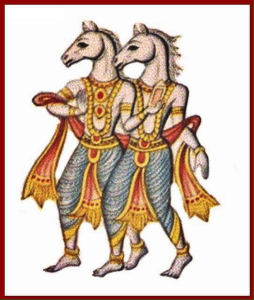Sanskrit in Lithuanian
In Lithuania, there are houses adorned with the motif of two horse heads. This is a small clue to Lithuania’s deep and ancient Vedic past.
Traditionally, the people of Lithuania worshipped the Asvieniai, the divine horse twins (Ashvin twins of Vedanta) related to the goddess Ūsinis (Ushas, Dawn) They are said to pull the Sun Chariot through the sky.
Ashvins, the children of the Sun god Surya, are summoned by the goddess Ushas (morning dawn) and appear as the morning and evening sunlight. They are practitioners of Ayurveda as Healers of the devas, demigods.
Lithuanian has preserved linguistically a great deal from Sanskrit, the original Mother Language of Europe. Below are a few examples of the linguistic similarities:
Asva(Lithuanian)=Ashva(Sanskrit) meaning ‘horse’
Dievas (Lithuanian)=Devas (Sanskrit) meaning ‘gods’, ‘the shining ones’;
Dumas (Lithuanian)=Dhumas(Sanskrit) meaning ‘smoke’
Sunus (Lithuanian)=Sunus(Sanskrit) meaning ‘son’
Vyras(Lithuanian)=Viras(Sanskrit) meaning ‘man’
Padas(Lithuanian)=Padas(Sanskrit) meaning ‘sole of the foot’
Ugnis(Lithuanian)=Agnis(Sanskrit) meaning ‘fire’
Vilkas(Lithuanian)=Vrkas(Sanskrit) meaning ‘wolf’
Ratas(Lithuanian)=Rathas(Sanskrit) meaning ‘carriage’
Senis(Lithuanian)=Sanas(Sanskrit) meaning ‘old’
Dantis(Lithuanian)=Dantas(Sanskrit) meaning ‘teeth’
Naktis(Lithuanian)=Naktis(Sanskrit) meaning ‘night’

Good collection. I remember Mahaperiyava also mentioning about the proximity of Sanskrit and the East European languages…
If you can add Latin and make it as 3 columns it would be more interesting…
Please check the below article in TOI the origin of all laungages are from mostly a remote place in Anatolia part of turkey now ! 👍
Mother of Sanskrit and related languages was spoken by Turkish farmers, says new study
https://timesofindia.indiatimes.com/india/mother-of-sanskrit-and-related-languages-was-spoken-by-turkish-farmers-says-new-study/articleshow/15633438.cms